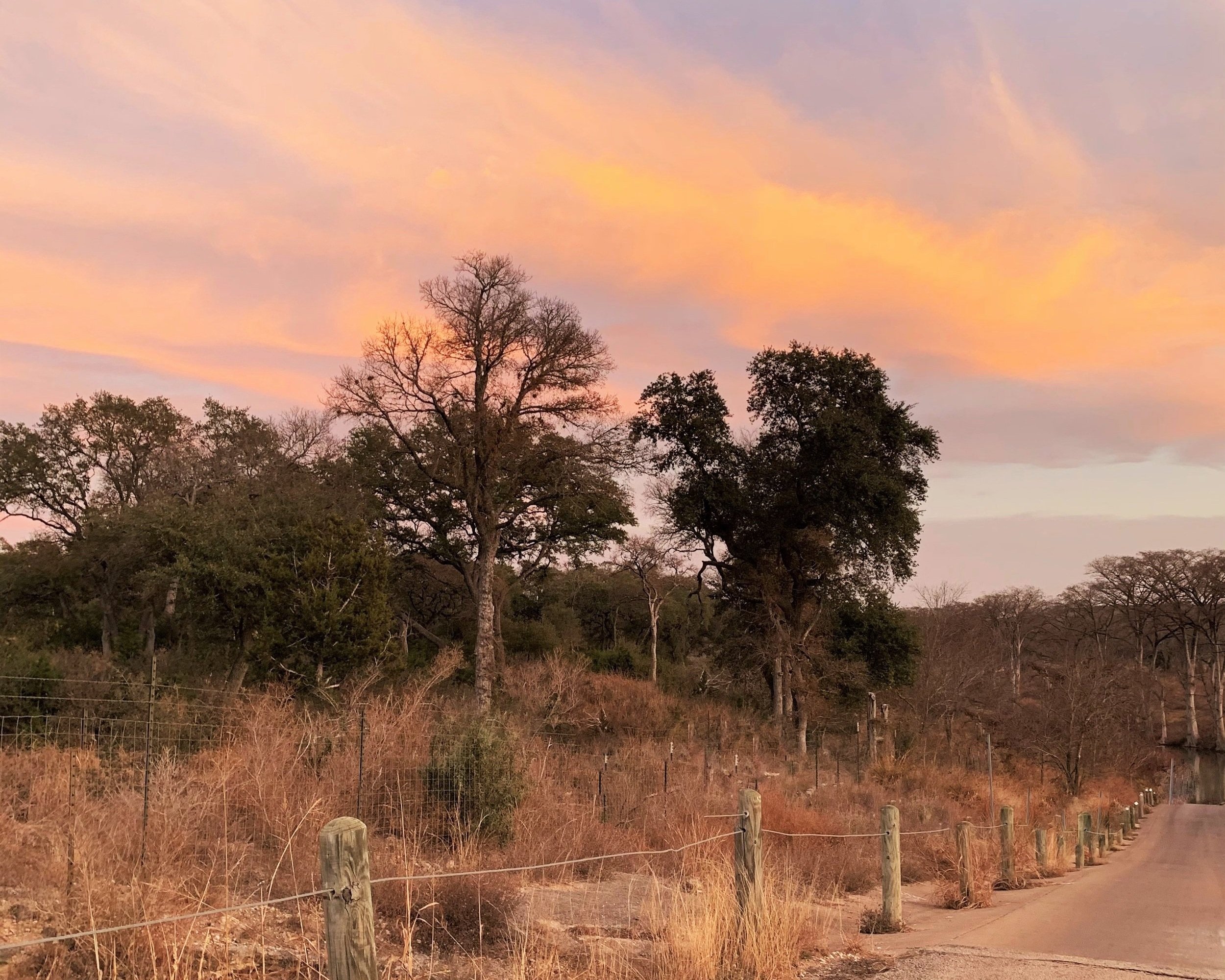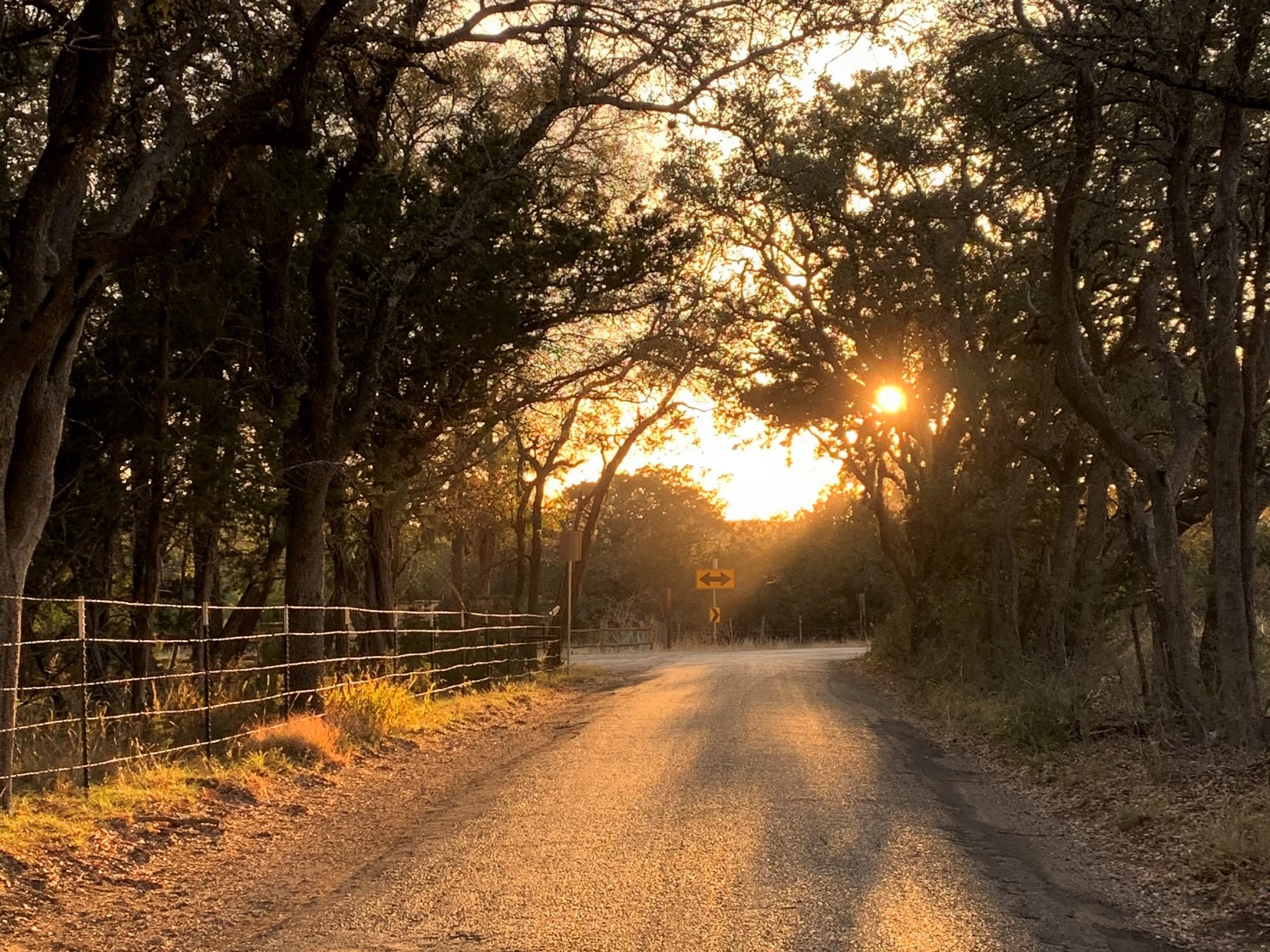Writing Nature
Nature—we live, love, and learn it. And we can WRITE about it too!
Mimi Cavender
We know stuff. We’d like to share it. But arrrgh, that blank page! If we’re in an academic community, sure, we have book writing and professional journals—formalized platforms—all a bit arrrgh-worthy. But if we write for The Hays Humm, online magazine of the Hays County Chapter of Texas Master Naturalist™, we can relax—it’s an ahhhhhh!
This article anticipates our readers’ interest in contributing to the magazine—and their possible qualms about it. Many of us go blank on the organization of our ideas before we even open our computer! But there are helpful formats available to simplify sharing your experience online. The Humm welcomes your writing and your photos. Let’s look at how easy it can be.
Approach to Slime Bridge at “magic hour” Photo: Rui Cavender
Relax. The Hays Humm’s tone is “informed informal.” It’s relaxed—but well organized. Organization of our ideas brings clarity of thought—to us and to our readers.
Here are eight comfortable ORGANIZATIONAL FORMATS often used by our writers. It’s important that you click on each link to read these especially well organized Hays Humm articles. You’ll enjoy them!
Report
Charro Ranch Workday by Michael Meves - September 2023
REPORT: See Charro Ranch Workday by Michael Meves.
The first paragraph usually answers the questions WHAT (event) took place? WHEN? WHERE? and WHO was involved (responsible persons or organization)?Following paragraphs can answer WHY (background, history) and HOW in more detail (the process and work involved), as in Spotlight on Master Naturalists at Work by Mary O’Hara - March 2023.
The concluding paragraph briefly touches on a wider context for the event, its importance, its impact on the future; or urges the reader to action.
Announcement
Christmas is Coming by Betsy Cross - December 2023 Photo by Rebekah Rylander
ANNOUNCEMENT: See Christmas is Coming by Betsy Cross.
An Announcement is like a Report (above) but shorter, usually organized as WHAT will take place, WHEN, WHERE, and then the WHO (organizers) and WHY (purpose). The HOW might be other details, such as instructions and what the event participants can expect. Don’t forget to send photos or graphics.
Book Review
Farming While Black by Martha Pinto Kinscherff - March 2023
BOOK REVIEW: See Farming While Black by Martha Pinto Kinscherff.
The first paragraph draws us in—briefly tells us about your encounter with the book (title and author)—why you were drawn to it.Following paragraphs tell us about one or two salient ideas or special strengths of the book and may include a short quoted passage to illustrate each.
The concluding paragraph tells why you think this book is interesting for Master Naturalists or anyone who cares about the natural world. If photos from the book or of its cover are online, send us a link. You can also take pictures of the book’s photos with your camera or cell phone as Martha did.
Good News! A book review is usually no more than a page or two; it just hints at the content and piques our interest to read it for ourselves.
Presentation
Things You May Not Know About Skunks by Dell J. Hood - February 2024
PRESENTATION: See Things You May Not Know About Skunks by Dell Hood.
This is “Show and Tell” information, as in an article or as a talk.The first paragraph or two engages your reader’s attention with an observation about your topic (humorous or surprising, or a shared human experience). Then give a quick preview of what aspects of the topic (= subtopics) that your article will include.
Following paragraphs provide details about each aspect of your topic in its own paragraph, with first mention of that aspect’s keyword bolded. Or you may choose to arrange your subtopics into the article’s sections, each section announced with the subtopic keyword.
The concluding paragraph includes the reader, perhaps projecting us into the future. An event Report with enriched information and excellent photos can easily combine with Presentation for a double-whammy hybrid.
Process
Modern Pictographs by Tina Adkins - March 2024
PROCESS: See Modern Pictographs by Tina Adkins.
The first paragraph tells how a project, as in Tina’s Modern Pictographs, or a technique, as in Irene’s Map Your Own Backyard, can be done step by step.Following paragraphs show the steps in the process (each step in its subtitled or bold keyworded section).
The concluding paragraph has language to the effect of That’s how we did it, and you can too!
Persuasion
The Sky’s Silent Spring by Mimi Cavender - July 2023
PERSUASION: See The Sky’s Silent Spring by Mimi Cavender.
This is like Presentation but includes your opinion, your bias, your take on the topic. You want to nudge our readers over to the Master Naturalist way of thinking about the natural world and persuade them to adopt environmentalist ideas and best practices.The first paragraph or section engages your reader. You share a meaningful experience with your reader that illustrates the NEED for our change of attitude or practices.
Following paragraphs or sections say that these things need to be done, and HERE’S HOW we can help one another.
The concluding paragraph says Let’s make it better for ourselves, our families, our property, our region, the planet. Persuasion can be subtle, too, in the format of Presentation, such as in Christine Middleton’s Land Stewardship in a Time of Climate Variability.
Informal Documentation / Personal Experience
Counting Birds by Betsy Cross - February 2024
INFORMAL DOCUMENTATION / PERSONAL EXPERIENCE:
See Counting Birds by Betsy Cross.
It’s perfect for photographing a group excursion or your hike in a natural setting—this can be, literally, a walk in the park, as in Autumn Trail.An introductory paragraph sets the who, where and when. Then just take good quality photos as you go. Arrange them in the order you took them along your walk. Use captions or brief narrating text to tie your photos together as we, the reader, accompany you through your experience. Throw in a few species names and pertinent nature or historical facts along the way.
A concluding paragraph invites readers to get out there and explore for themselves. Easy peasy.
Annotated Photo Gallery
April Pretties by Constance Quigley - May 2023
ANNOTATED PHOTO GALLERY: See April Pretties by Constance Quigley.
If you take great nature photos—high resolution cell phone pics are fine!—you can gather some up within a unifying theme: weather, location, a family or species, relationship between plant and pollinator, or the season, as in Constance’s It’s Blooming Hot.Write a brief introductory paragraph mentioning the theme, and provide a short caption for each photo. There’s minimal writing here, and Humm readers LOVE this!
Hybrids! When you’re familiar with them, each of the eight organizational formats above can include aspects of others, sometimes as addended sections (“sidebars”). As you relax into this—and you will!—you’ll add your special humor and personality. Click on this hilarious mix of Report and Presentation: Loren Steffy’s 2023 HCMN Gala with added information about river cooters. Check out the triple hybrid Documentation + Presentation + Persuasion in Tom Jones’ Low Flow.
Now, with your camera in hand, look for easy photo opportunities! You’ll see nature stories everywhere—out driving, along the fence line, on a walk, your local park, your bird feeder, your own back yard!
Think theme. Imagine a story, education, outreach. The photos, chosen thematically, will often suggest the story you tell, the content you write. They’ll do most of the work for you.
Choose an ORGANIZATIONAL FORMAT from those suggested above. And voilà!—you’ve written your beautifully illustrated Hays Humm article to share online with us all!
We can’t wait to read your work!





